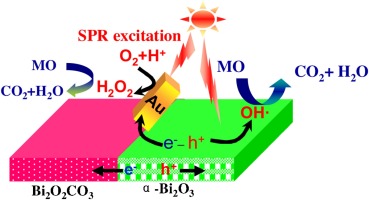当前位置:
X-MOL 学术
›
Appl. Catal. B Environ. Energy
›
论文详情
Our official English website, www.x-mol.net, welcomes your
feedback! (Note: you will need to create a separate account there.)
Integrating plasmonic Au nanorods with dendritic like α-Bi2O3/Bi2O2CO3 heterostructures for superior visible-light-driven photocatalysis
Applied Catalysis B: Environment and Energy ( IF 20.2 ) Pub Date : 2015-11-26 03:15:14 Changlin Yu, Wanqin Zhou, Lihua Zhu, Gao Li, Kai Yang, Rongchao Jin
Applied Catalysis B: Environment and Energy ( IF 20.2 ) Pub Date : 2015-11-26 03:15:14 Changlin Yu, Wanqin Zhou, Lihua Zhu, Gao Li, Kai Yang, Rongchao Jin

|
To explore the relationship between semiconductor structure and plasmonic noble metal nanoparticles (NPs) property is crucial for developing highly efficient visible light driven photocatalyst. Here, dendritic α-Bi2O3/Bi2O2CO3 biphasic heterostructures were first synthesized by a facile and low-cost phase transformation method. Then, plasmonic Au NPs (including Au nanospheres (NSs, ∼30nm)) and Au nanorods (NRs, ∼20, ∼30, and ∼35nm) were loaded onto the α-Bi2O3/Bi2O2CO3 heterostructure. The results revealed that these α-Bi2O3/Bi2O2CO3 heterostructures exhibited much higher visible-light photocatalytic activities than α-Bi2O3 for dye degradation. More importantly, compared to plain α-Bi2O3/Bi2O2CO3 heterostructures, loading of Au NSs brought ∼4 times increase in activity and Au NRs 5–11 times depending on nanorods size. The significant boosting of activity is attributed to the large enhancement of charge separation by the formation of α-Bi2O3/Bi2O2CO3 interface and more production of OH radicals by Au NSs or Au NRs. The surface plasmon resonance (SPR) absorption of these gold NPs on the α-Bi2O3/Bi2O2CO3 heterostructures could also have significant contribution to the activities due to their strong plasmonic near-fields. This work demonstrates that tailoring the semiconductor substrate structure and the plasmonic noble metal NPs properties should constitute a promising strategy for the design efficient solar energy driven photocatalytic materials.
中文翻译:

将等离激元Au纳米棒与树枝状的α-Bi2O3/ Bi2O2CO3异质结构整合在一起,以实现出色的可见光驱动光催化作用
探索半导体结构与等离激元贵金属纳米粒子(NPs)性能之间的关系对于开发高效可见光驱动的光催化剂至关重要。这里,树突α-Bi系2 ö 3 /铋2 ö 2 CO 3双相异质结构首先通过一个浅显且低成本的相变方法来合成。然后,等离激元的金纳米粒子(包含Au纳米球(NSS,~30nm))和Au纳米棒(NRS,约20,约30,和~35nm)被加载到α-Bi系2 ö 3 /铋2 ö 2 CO 3异质结构。结果表明,这些α-Bi系2 ö 3 /铋2层ö 2 CO 3的异质结构显示出比α-Bi系高得多的可见光的光催化活性2 ö 3染料降解。更重要的是,相对于普通的α-Bi系2 ö 3 /铋2 ö 2 CO 3的异质结构,金NS的负载带来的约为4倍的活性增加和Au NRs的5-11倍根据纳米棒的大小。的显著升压活性是通过形成归因于大的增强电荷分离α-Bi系2 ö 3 /铋2 ö 2 CO 3界面和Au NSs或Au NRs产生更多的OH自由基。在α-Bi系这些金NP的表面等离子体共振(SPR)吸收2 ö 3 /铋2 ö 2 CO 3异质结构也可以具有与活动显著贡献由于它们的强等离子体激元近场。这项工作表明,调整半导体衬底的结构和等离激元贵金属NPs的特性应该构成设计高效太阳能驱动的光催化材料的有前途的策略。
更新日期:2015-11-26
中文翻译:

将等离激元Au纳米棒与树枝状的α-Bi2O3/ Bi2O2CO3异质结构整合在一起,以实现出色的可见光驱动光催化作用
探索半导体结构与等离激元贵金属纳米粒子(NPs)性能之间的关系对于开发高效可见光驱动的光催化剂至关重要。这里,树突α-Bi系2 ö 3 /铋2 ö 2 CO 3双相异质结构首先通过一个浅显且低成本的相变方法来合成。然后,等离激元的金纳米粒子(包含Au纳米球(NSS,~30nm))和Au纳米棒(NRS,约20,约30,和~35nm)被加载到α-Bi系2 ö 3 /铋2 ö 2 CO 3异质结构。结果表明,这些α-Bi系2 ö 3 /铋2层ö 2 CO 3的异质结构显示出比α-Bi系高得多的可见光的光催化活性2 ö 3染料降解。更重要的是,相对于普通的α-Bi系2 ö 3 /铋2 ö 2 CO 3的异质结构,金NS的负载带来的约为4倍的活性增加和Au NRs的5-11倍根据纳米棒的大小。的显著升压活性是通过形成归因于大的增强电荷分离α-Bi系2 ö 3 /铋2 ö 2 CO 3界面和Au NSs或Au NRs产生更多的OH自由基。在α-Bi系这些金NP的表面等离子体共振(SPR)吸收2 ö 3 /铋2 ö 2 CO 3异质结构也可以具有与活动显著贡献由于它们的强等离子体激元近场。这项工作表明,调整半导体衬底的结构和等离激元贵金属NPs的特性应该构成设计高效太阳能驱动的光催化材料的有前途的策略。

































 京公网安备 11010802027423号
京公网安备 11010802027423号